The main discovers that I found in the Herbert Hoover Collection this week was bibliographical materials, mostly photos or photocopies of Mr. and Ms. Hoovers and some form there estates. Most of this publicity was due the collection being donated to Harvey Mudd College and the College attempting to gain more prestige for this collection. After all when the collection was donated to Harvey Mudd the College was only 20 years old. Furthermore, I can across an article in The American road, which stated that already three journalists received awards for the Hoover-related stories in 1987. Hence, in turn, increasing the publicity of Harvey Mudd college.
Herbert Hoover Discovers
When the Hoover Collection was first processed, it was actually at Sprague Library at Harvey Mudd College. Herbert Hoover the third donated the collection originally to Harvey Mudd College, and they created a Sprague Library to house the material. It created a lot of popularity for Harvey Mudd College, however, Sprague Library was ill-prepared to take on such a collection. I found the initial report recording the lack of temperature control (a cool temperature is critical for books, so they do not get damaged). Furthermore, there were reports of vandalism and petty theft. Additionally, researchers were reading the materials in the same room where the collection was being housed, which could encourage theft. Sprague Library did improve these conditions. Currently, Sprague Library no longer exists, and the materials got moved to the Honnold Mudd Library instead. It is fascinating to learn the history behind the cataloging of such an impressive collection.
Return to Processing
I returned to Claremont after my summer break. I am now processing, reorganizing, and refoldering the documents within the Hoover Collection. I have focused mainly on the 1970s and the 1980s form when the Collection was first donated to the library. I got the opportunity to see my collection in action. There was a display of some of the books within the Hoover Collection to a geology class. It was awesome to talk about the collection and my work with people. Additionally, it is amazing to see the amazing job that archivists do to preserve sources. Additionally, I feel as though I getting to experience an intimate knowledge with the matieral- uncovering the mystery of how people came to understand the Hoover Collection. Furthermore, I got to learn new library science skills like photocopying folders to acidic-free paper and getting to witness acid burn and rusty on paper first hand made me fully appreciate history and the material even more.
Dull Knife, the Cheyenne and the Pursuit of Self-Determination
What constitutes a hero? Some might be tempted to list attributes, deeds, or point to a righteous struggle in which one emerges victorious. I have come to understand that heroes are mainly subjective, and many who are heroic are not catalogued the way, or to the extent, they deserved. Many Native Americans displayed unabashed heroism when colonizers encroached on their land, families, livestock and livelihood. One of these was Dull Knife of the Northern Cheyenne Nation.
I was particularly moved by the story of Dull Knife, the Cheyenne and their hard fought struggle to remain autonomous. Dull Knife was no stranger to resistance or battle, he fought in the Cheyenne-Arapahoe War, the Sioux Wars of the Northern Plains, and fought alongside Crazy Horse and Sitting Bull during the War for the Black Hills. The Native Americans were underestimated, and after each battle they, along with their Chiefs, made their formidable posture known. As such, General George Crook coordinated a surprise attack on Dull Knife’s camp. Those who survived fled and surrendered elsewhere. Subsequently, they were forced onto a reservation in Oklahoma that touted little game, unfamiliar weather and was host to diseases.
In 1878, Dull Knife and 300 others fled, unable to bare the deplorable conditions the colonizers had provided for them. They all began a 1000 mile journey with a single step. On this journey they were forced to split up, reconfigure and eventually surrender at Ft. Robinson. A year after the death of Dull Knife, the Northern Cheyenne were granted the Tongue River Reservation in Montana.
The later years of Dull Knife’s life were marked with struggle, oppression, concealment and brutalization. He never lived to see the small consolation of a reservation, closer to their home of Wyoming, awarded to his people. Even so, he never wavered in his struggle for freedom. He never caved to the proposals of assimilation or displacement, and no matter how hard the white invaders tried, they could never scrub history of his influence or his stature. Rather, like many Native American Chiefs, his struggle casts a large shadow over society 150 years later. The shadow of his heroism, and the heroism of those like Crazy Horse and Sitting Bull, eclipse the American platitude of “liberty and justice for all”. When one takes the time to learn about those like Dull Knife, they are met with the duty to acknowledge that we are truly an imperfect nation, founded by imperialism. Barbara’s collection reminds me that the term “Founding Fathers” is a misnomer. John Adams, Thomas Jefferson, nor the others founded this land. On the contrary, it was the ancestors of those like Dull Knife and Barbara herself who are true founders.
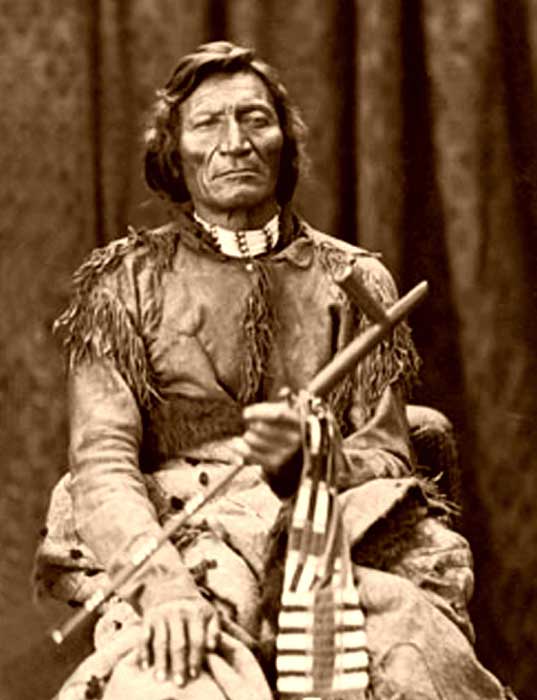
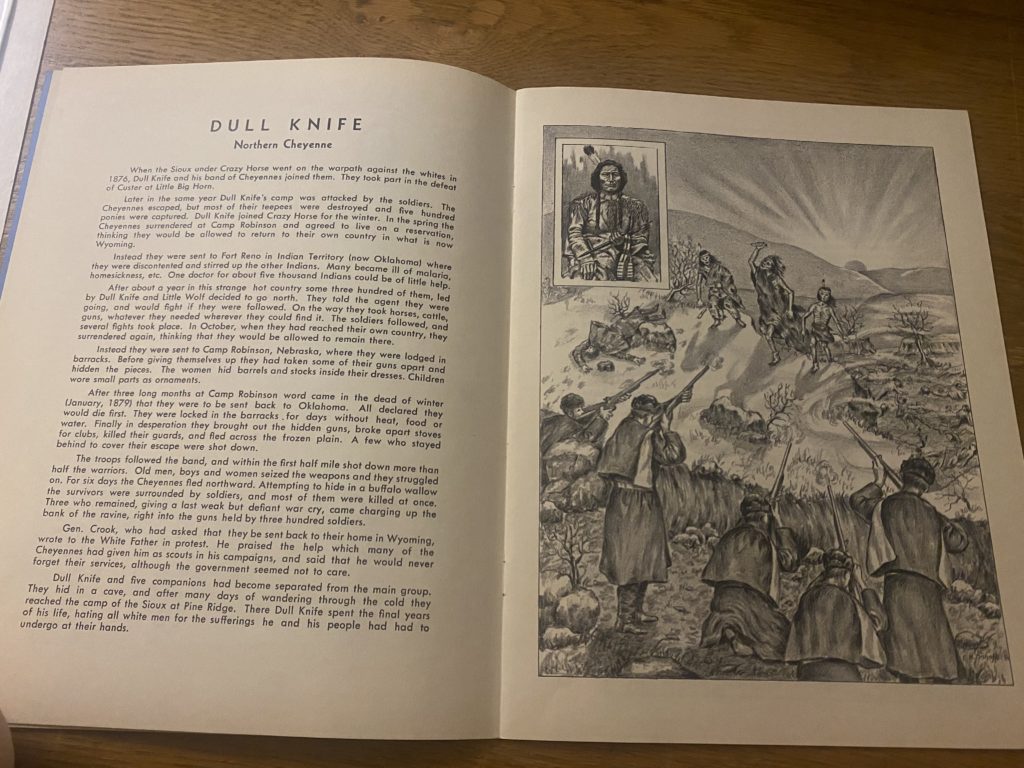
Keeping History Alive
I am happy to report that after weeks of poring through Barbara’s materials, the CCEPS team has finally divided all materials into subject-specific categories. These subject-specific categories correspond to parent thematic categories that will span the entire collection. As we move past this phase, I would like to share some key words I think encompass the spirit of this collection.
The first is historical. Barbara took incredible measures to preserve information relating to her Native American heritage. These span all types of mediums. She had newspaper clippings, magazine clippings, article print-outs, Indigenous curriculums, and many more elements. Similarly, Barbara did not only go through the trouble of preserving information regarding the Tongva/Gabrielino, she had an incredible wealth of knowledge regarding other Indigenous nations. She has information pertaining to the Sioux, Chumash, Navajo, Nez Perce, Cheyenne and many others. In other words, Barbara’s collection is useful for anyone that seeks to learn any facet of American history. There can be no true American history without the understanding of the Indigenous history that preceded it.
The second is community-oriented. Not only are the materials of the Drake collection an essential resource for anyone interested in history, they also retain great interest for those who are seeking to organize. What I’ve gleaned from Barbara’s collection is that she was an incredible organizer, her personal projects– ranging from the Chia Café Collective to Preserving Our Heritage– were never free from cause, purpose or diversity. Furthermore, she took the time to retain documents (flyers, brochures, itineraries, etc.) from other sources of Indigenous community engagement. These documents serve as formidable blueprints for anyone looking for ways to mobilize or embrace their own community.
The last is representative. A common thread through the whole of the Drake collection is the elevation and centrality of Indigenous voices, perspectives and character. This representation is desperately needed in today’s society, while many underserved communities are still fighting for a seat at the table, or some measure of justice. This is one of the many reasons the value of the Drake collection can not be overstated, it embodies the perspective of a beloved Tongva elder who was diligent in the pursuit of teaching and learning about her culture.
Barbara appeared to be a life long learner, it’s apropos that her collection encourages the same.
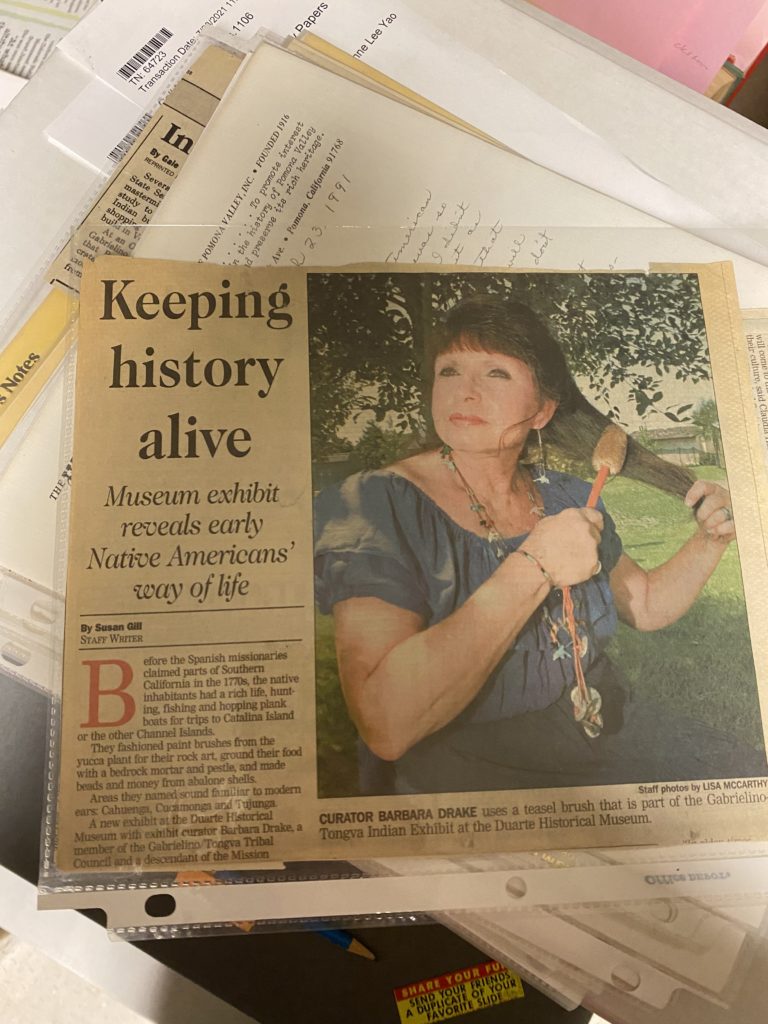
Roots of an Archive
When first considering how to arrange the Barbara Drake’s archive, I was focused, also maybe too compelled, on the material. I wanted to delve into the subjects, whether that was tribal history, ecology, cosmology, or curriculum, and parse them out. The collection itself is extensive. The project of sort was certainly one that would take time and patience.
What we forgot, and thankfully our project manager reminded us, was that all these materials were the research, pedagogy, and experiences of Barbara Drake. The arrangement pivoted. Now we’re arranging for her. Who was Mrs. Drake and what did she do? That’s one series. What did she research? That’s two. How to educate and what to educate students with? That’s three.
Barbara Drake, known as “Auntie Barbara” by students, faculty, and staff at Claremont Colleges, was instrumental in fostering collaboration between the local Tongva community and Claremont. I never met her, but I’ve read and heard about her boundless care, mentorship, joy, wisdom, and knowledge. Her research and pedagogy reflected her connection to the earth. To her, the natural world was the center of all life in cultural history, storytelling, tradition, and in part of holistic community.
Based off the stack of ecological materials, I lament not having got to know her and even just taking a class. The amount of knowledge compiled, just on local plants alone, is deeply inspiring. I want to continue a journey on a similar path: to understand better the people and place that I consider my home.
What Remains
This week, my colleague and I successfully organized all of Barbara’s materials into their parent categories pertaining to research, education and Drake’s biographical materials. While sorting materials into the category pertaining to Drake herself, it was impossible not to notice what a purposeful, full and meaningful life she led. Her efforts made in the pursuit of reparations for Indigenous peoples was both wide in breadth and tangible success.
Some of the materials I was struck by surrounded the legal battle between CSULB and the Gabrielino/Tongva Nation to reinter remains found on CSULB campus property, remains consistent with the geographical and chronological ancestry of the Los Angeles Basin Native Americans. In short, in Long Beach, and other areas of Los Angeles county Indigenous remains had been found during the process of commercial development throughout the decades. During the many decades of enduring the painful displacement of ancestors, Native Americans were often required to obtain legal representation to pursue their right to reinter their ancestors. From the documents carefully preserved by Barbara, it appears this was the case for ancestors found in proximity to CSULB as well.
After a lengthy process of litigation, a portion of the ancient Indigenous village of Puvungna located on the CSULB campus, was preserved as a site of Indigenous cultural significance. As recently as 2021, the site was formally protected in perpetuity, ensuring no construction or development would ever be permitted to disturb the land again. It must be noted, that Barbara Drake, along with others in her Indigenous community placed themselves on the front lines of litigation to preserve their culture, heritage and civil liberties for generations to come. It must be dually noted that these efforts were pursued, even when local, state and federal governments had the nerve to seek to dismiss the wishes (in full or in part) of Indigenous descendants on the grounds of “lack of federal recognition”. To this, I ask, what good is “federal recognition” when the identities and existence of factions like the Gabrielino/Tonva Nation preceded the existence of the government and the United States as a whole? Barbara’s collection thus far has taught me many things I didn’t know I had to learn, and has afforded me a wider scope in which to consider history. I am confident this collection will have the same effect on anyone that interacts with its hugely significant contents.

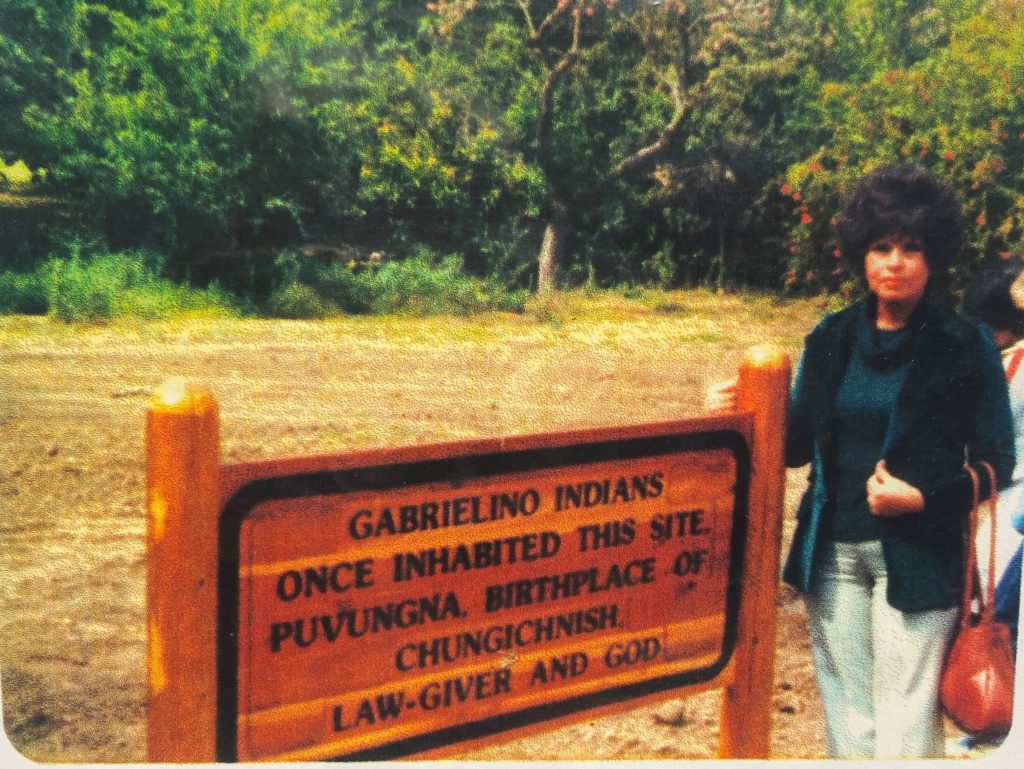
Mysteries of the Desert
As mentioned previously, due to the nature of the current phase in which we are archiving Barbara Drake’s collection, I have given myself much more freedom to engage with the specific materials. This past week, I found myself lost in the research Drake had compiled regarding ancient Indigenous history, and the artifacts that contributed to some of this understanding. Doing so, I learned a word I had never heard before– intaglio.
An intaglio, or a geoglyph, can be found prominently in the stretch of desert that connects Arizona to California. Their ancient construction resulted from the displacement of dark stones to reveal the light soil underneath, etchings that created a permanent symbol of prehistoric ancestries. According to an April 1989 issue of Arizona Highways these etchings are believed to be anywhere from 150, to 5,000 years old. Additionally, these etchings range anywhere from 20 feet in diameter, to over 150 feet. One intaglio, 75 miles west of Phoenix, measures an incredible 300 feet. These intaglios bear the resemblance of human figures, snakes, lizards, mountain lions and other geometric shapes. So, what does it all mean? Archaeologists mainly contend that these geoglyphs were intended to communicate with Native gods. The tone of communication exists on a speculative continuum ranging from praise and honor, to cries for help, imploring divine intervention to assuage the cruelty of an unrelenting and changing landscape. The aforementioned geoglyphs provide a peek into a time where the veil between spirituality and mortality might have been thinner.
These relics of a distant past, and their mystery, illustrate how much history was lost to colonialism. Not only did colonizers do their best to eradicate the powerful Native themselves, they simultaneously robbed future persons of enculturated sources for which clues to human history might exist. Due to the genocidal force that perpetuated colonialism, much of the primary, secondary or even tertiary source material regarding the spirituality of the ancient Native has been lost. Luckily, caretakers of culture and heritage, like Barbara Drake and her fellow Indigenous peoples, have preserved what is left and seek to reclaim what is yet to be discovered.
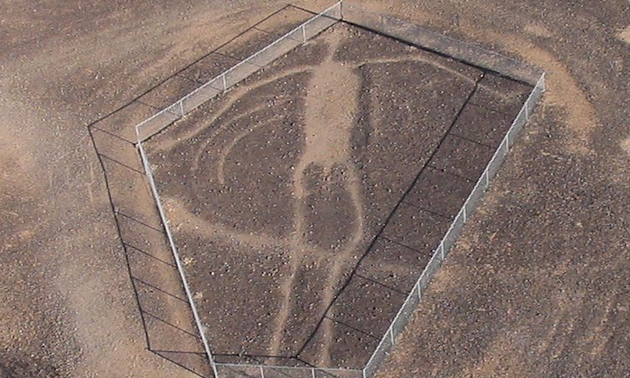

American History: The Unabridged Version
This week the Barbara Drake collection has undergone a sort of restructuring. Materials are being sorted into more specific categories and the collection has started to take somewhat of a shape. Due to the extensive nature of Barbara’s contribution, we are still a long way from finality. Sitting with Barbara’s materials this week, in an effort to ascribe items to subject-matter specific categories, I took more time than usual indulging the curated research.
History was always my favorite subject in primary school. I had a second grade teacher who put together a slideshow of early 1900s Los Angeles, I was transfixed by how different the world seemed. There was no Staples Center or Walt Disney Concert Hall. There was no Geffen or Phillipe’s (though depending on the year of the photos, it would be soon to come). The roads were suspiciously absent of BMWs and Honda Civics. It wasn’t until too many years later that I realized Spanish colonizers did not birth Los Angeles, as I had been told, rather the Tongva had. Just like many facets of American history, fashioned to be palatable for American children, this was yet another important fact that had been conveniently left out of the textbooks. Many years out of primary school, I can say that had I been taught the unabridged history then, it would have helped me conceptualize America’s tumultuous history much sooner. Much sooner would I have understood who rightfully owned my beloved Los Angeles. I am fortunate to be an informal student of Barbara’s materials, through which she has gracefully and posthumously educated me on the real history of America– before the Americans. This collection, for me, has highlighted the grave disservice we do to our public school children when we obfuscate such history from them. However, this collection will be a great resource for those interested in ecology, Indigenous ethnohistory, archaeology and more. With scholars like Barbara, determined to leave the world better and more informed than they found it, those who engage with her materials (and materials like hers) can facilitate an honest understanding of America’s true history.

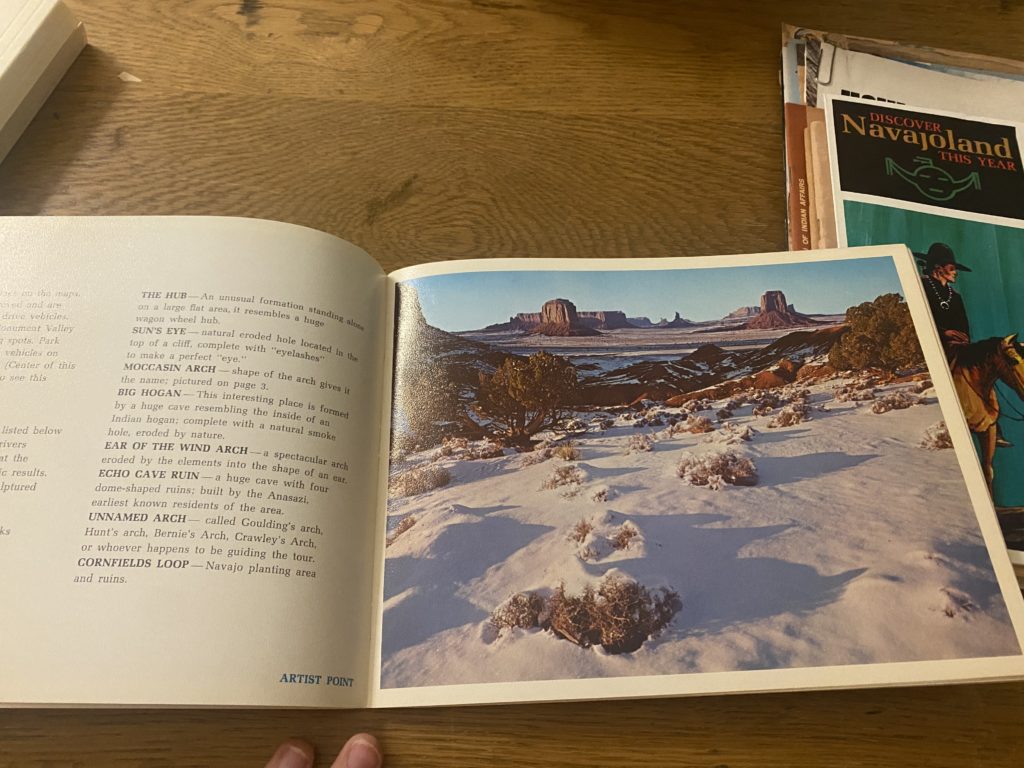
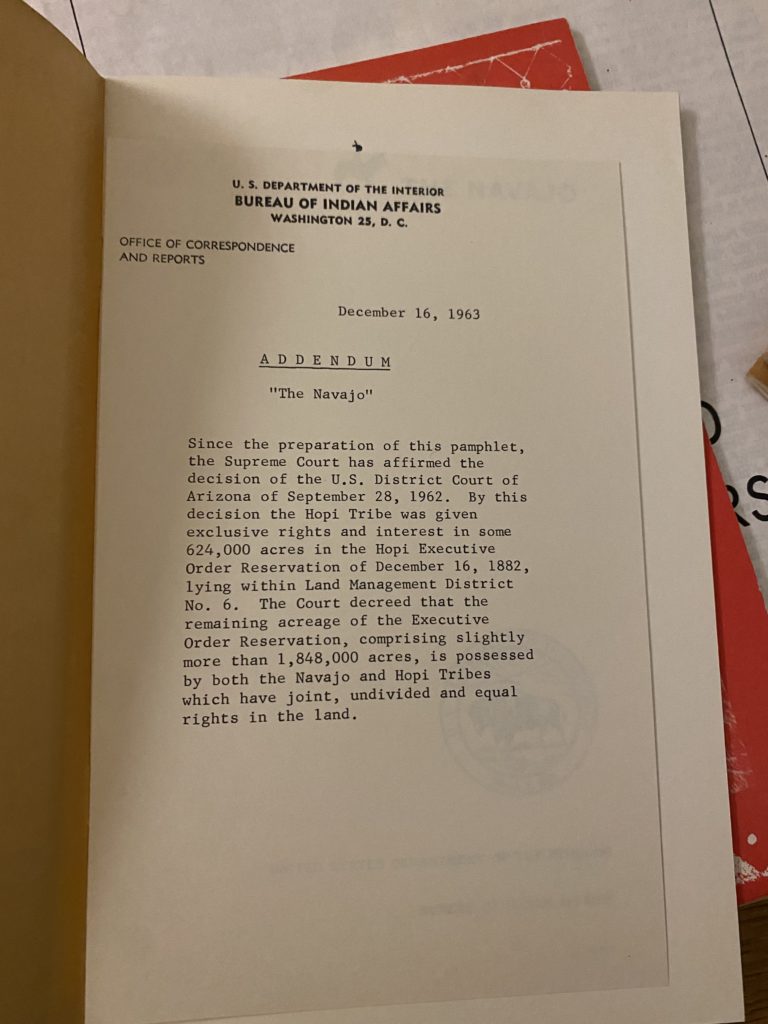
Wrap-Up Reflections
This week, I put the finishing touches on my exhibit and published it to the CCEPS Omeka website. Wrapping up the project, I get to reflect on the experience of engaging with primary sources, digitizing them, and presenting them to be read by the public. After this summer, I feel much more equipped to complete humanities-based research. I’ve learned how to review literature and find relevant secondary sources and databases. More interesting, however, is the new perspective I gained towards the process of data analysis. As a statistics student, I work a lot in large sets of raw data. The primary sources are, in many ways, like that raw data. To researchers, by themselves, large volumes of magazines are very difficult to interpret without first deciding which data is most important to look at, and what they are looking for within that data. They then must come up with a process for organizing and analyzing the data.
We, as researchers, get to influence truth by framing and choosing which data to include and deem relevant in our projects. We can seek to process materials responsibly, but we must also recognize our biases going into projects. I wanted to find a point to prove when I entered this project, but I learned that the data was far too large, expansive, and incomplete to prove one large point. If I want to continue my research in the future, I must find more qualifiable and specific data to trace a specific phenomenon. I home that through my broad framing of the primary source data available at the Claremont Colleges Library and Ella Strong Denison Library, I can encourage others to access the materials which will hold so many answers when we learn to ask strong questions.